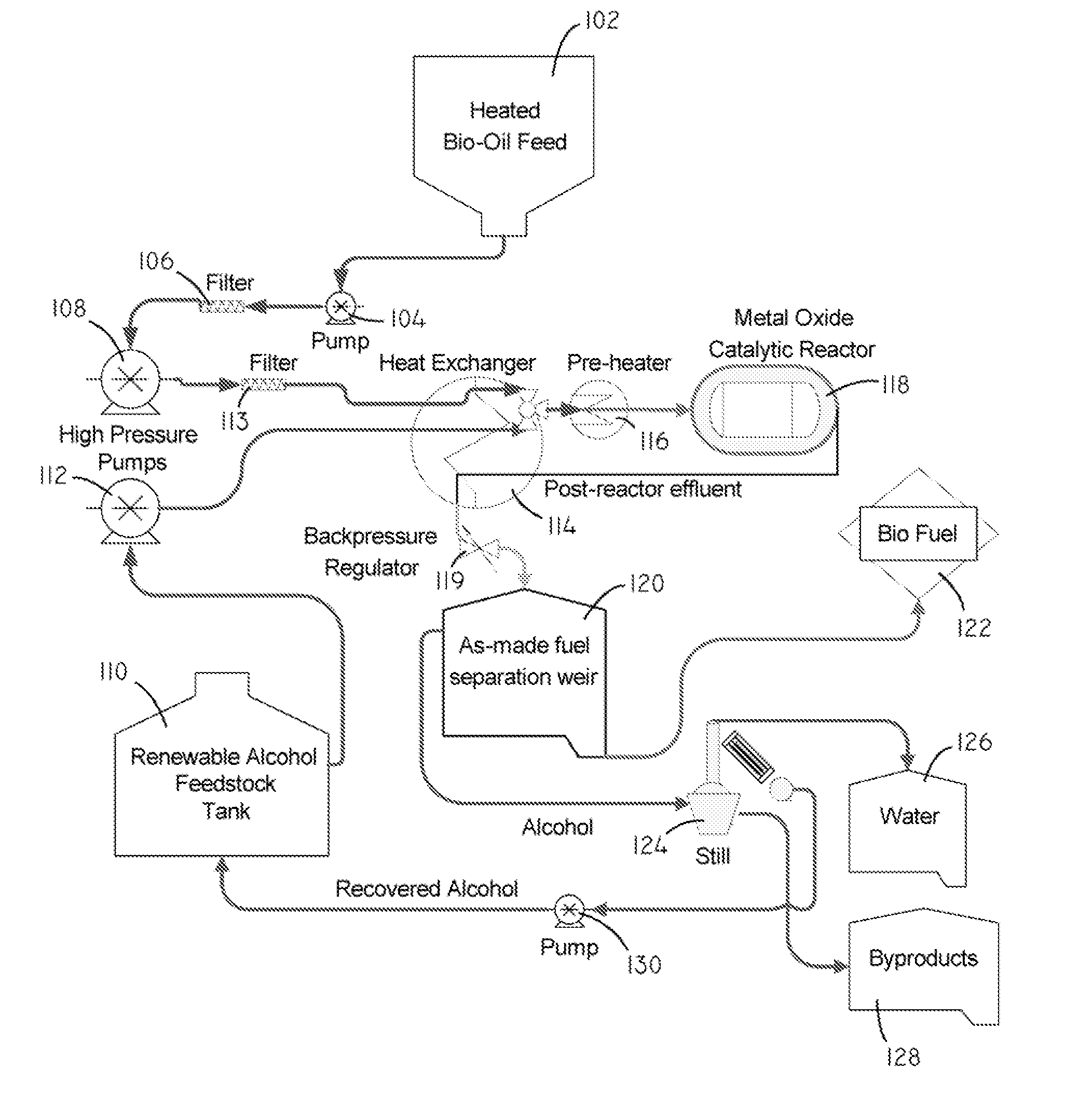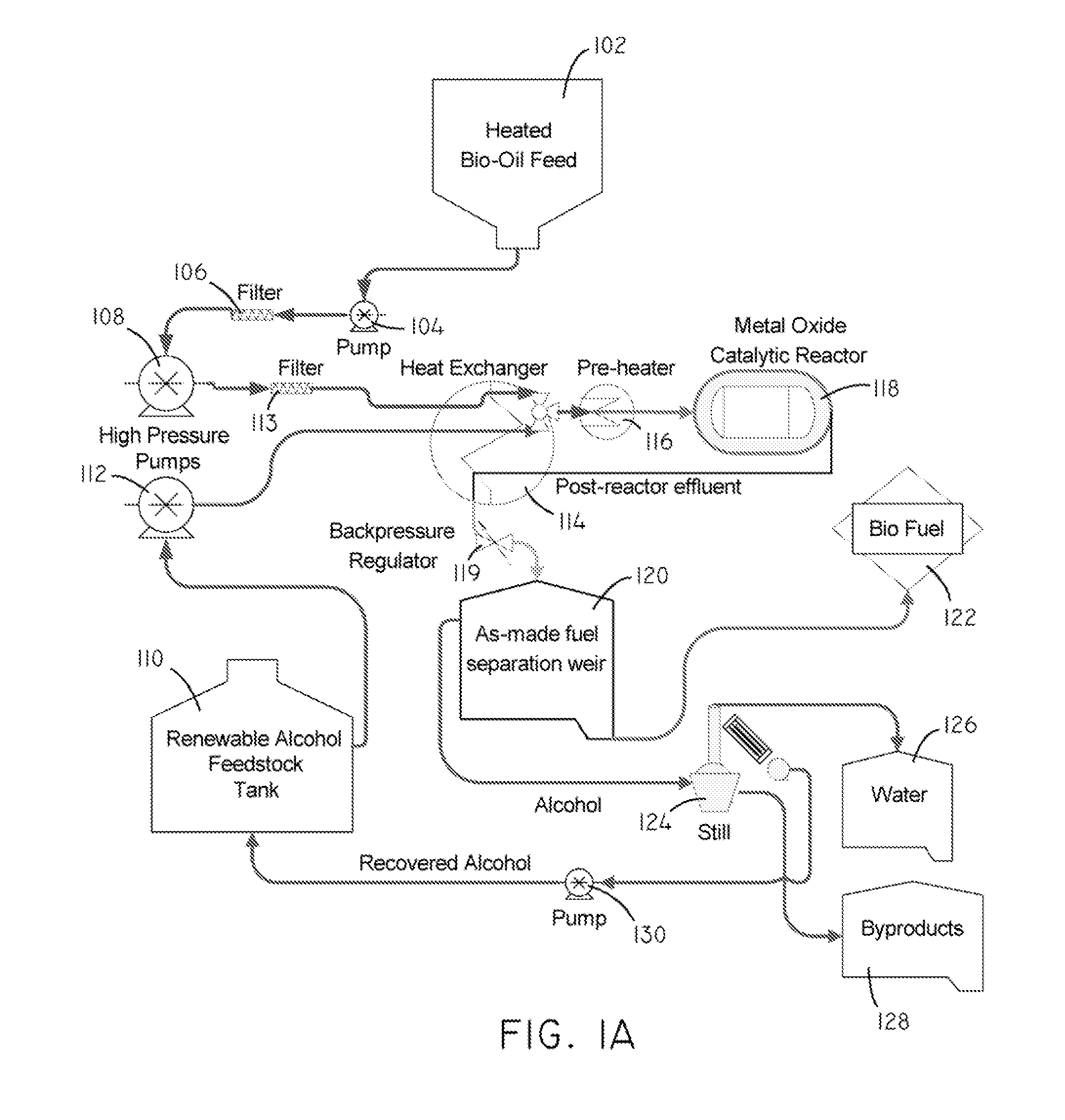Systems and methods for producing fuels from biomass
a technology of biomass and fuel, applied in the direction of hydrocarbon oil treatment products, group 3/13 element organic compounds, raffination with non-metals, etc., can solve the problems of high cost, high cost, and high and achieve the effect of reducing the cost and improving the efficiency of pyrolysis oil production
- Summary
- Abstract
- Description
- Claims
- Application Information
AI Technical Summary
Problems solved by technology
Method used
Image
Examples
example 1
Formation of Reactor Columns
[0064]Titania (80 micron, 300 Å) particles were obtained from ZirChrom Separations (Anoka, Minn.). Particles were packed at ZirChrom Separations (Anoka, Minn.) into reactor columns using a downward slurried high-pressure packing station (Alltech Associates, Deerfield, Ill.). The particles were packed into all-stainless steel column hardware obtained from Isolation Technologies (Hopedale, Mass.). The reactor was outfitted with 2-micron stainless steel frits.
[0065]Specifically, two reactor columns were prepared; the smaller had a dimension of 0.46 cm i.d.×15 cm length and the larger a dimension of 1.0 cm i.d.×15 cm length. A slurry was first formed by adding the zirconia particles to HPLC-grade methanol (7 g of particles in 20 g of MeOH or 23.5 g of particles in 40 g of MeOH for the small and large reactors, respectively). Reactor packing pressures of 7,000 PSI was used with methanol as the pusher solvent. The reactor was allowed to pack and compress for 30...
example 2
Refining System Design
[0066]Specifically, one high pressure Waters 590 HPLC pump (obtained from Waters Corporation, Milford, Mass.) was set up to draw from a reservoir that included bio-oil diluted with an alcohol that was continuously sparged with nitrogen to minimize the effect of dissolved oxygen on the system. The system was set up so that the bio-oil / alcohol solution would be pumped through a stainless steel (1 cm i.d.×15 cm long) tube fitted with two 2 micron stainless steel frits (acting as a filter) before it entered the heat exchanger.
[0067]The bio-oil / ethanol solution stream was pumped into a custom designed heat exchanger that consists of welding together two ⅛th inch o.d. stainless steel tubes (Alltech Associates, Deerfield, Ill.) with silver solder where the heat from the hot effluent from the reactor is exchanged with the one incoming reactant stream (bio-oil ethanol solution). After the heat exchanger the one reactant stream passed through an electrically driven prehe...
example 3
Synthesis of Diesel Equivalent Fuel from Pyrolysis Oil (Bio-Oil)
[0068]A sample of bio-oil (pyrolysis oil) formed from corn stover using a microwave assisted pyrolysis technique was obtained. The bio-oil was first dissolved in an organic solvent (e.g. ethanol, hexane) to lower the viscosity and ethanol was also used as a reactant. The bio-oil feedstock was then centrifuged at 10,000 G for 6 minutes and then filtered through a 5 micron membrane filter. The residence time was held constant at 2 minutes and the reaction temperature was set to either 300 or 350 degrees Celsius.
[0069]Samples of the products produced at both temperatures were then taken and the remaining reaction products were subjected to distillation through rotary evaporation. The fractions were as shown in Table 1.
TABLE 1IDDescription300° C. Celsius300-1Crude undistilled product fraction.Fractions300-2First distillate to be collected byrotary evaporation of crude product.300-3Second distillate to be collected byrotary ...
PUM
 Login to View More
Login to View More Abstract
Description
Claims
Application Information
 Login to View More
Login to View More - R&D
- Intellectual Property
- Life Sciences
- Materials
- Tech Scout
- Unparalleled Data Quality
- Higher Quality Content
- 60% Fewer Hallucinations
Browse by: Latest US Patents, China's latest patents, Technical Efficacy Thesaurus, Application Domain, Technology Topic, Popular Technical Reports.
© 2025 PatSnap. All rights reserved.Legal|Privacy policy|Modern Slavery Act Transparency Statement|Sitemap|About US| Contact US: help@patsnap.com



